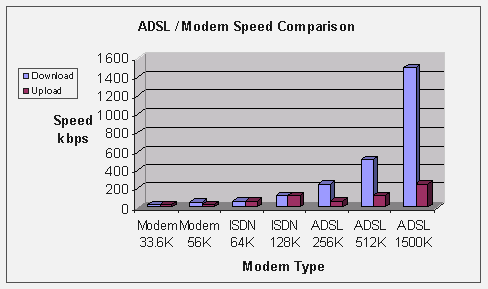Q: What is ADSL?
A: ADSL, which stands for
Asymmetric Digital Subscriber Line, is a broadband communication
technology designed for use on regular phone lines. It has the ability
to move data over the phone lines at speeds up to 20 times speedier than
the fastest analog modems available today.
Q: What are the benefits?
A: In addition to their
very high speed, ADSL modems have many benefits over analog modems.
Unlike the dial-up connections required for analog modems, your ADSL
connection is always on. That means no more logging on and off, no more
waiting for the connection to happen - it's always there. Another
benefit is the ability to use the phone at the same time the data
connection is on; you don't have to choose between the two.
Q: Do I need a second phone line
for DSL?
A: No,
a 2nd phone line is not needed, DSL works over your existing line. The
circuit to your home is split into 3 channels: voice, and 2 data
channels (upload/download). You will still be able to talk on the phone
and have high speed Internet access at the same time.
Businesses using a modem connection will typically
dial the Internet many times each day, which adds up to a significant
monthly phone bill. You can eliminate these charges completely by
changing over from a modem connection to DSL. Also, if you had
previously dedicated a phone line to your Internet modem, you could
cancel this line and then pocket over $30/month savings in line rental!
Q: How can it be so much faster than a modem when
it uses the same phone line?
A: Analog modems send their signals
through the public switched telephone network, the same one that
connects ordinary telephones. ADSL modems "piggyback" their signals on
top of the voice signal. On the phone company's premises, the line gets
split - the voice calls are sent to the public switched telephone
network, and the data transmission goes to the Internet. This method
moves data off the phone companies' lines and instead uses connections
optimized for carrying Internet traffic.
Q: I don't exactly understand the
difference in speed. How much faster is DSL compared to
Dial-Up?
A: Maybe a
graphical representation of the difference in speed will
help.

Q: Will it constantly connect near the maximum
speed, or will it be like my 56K modem that almost never connects at
56K?
A: At ADSL speeds, the limitations
are much more the performance of the Internet server you're trying to
reach and the amount of traffic on the Internet. The Internet is a
loosely coupled network of computers that are transmitting data by
different methods through different computers at different speeds, so
the speed you receive data with an ADSL modem is limited by these
factors.
Q: Will it work with my computer?
A: Yes, and the
newer the computer the better the performance. If your computer is
already configured to operate on a local area network (LAN), it will
have a network interface that can connect to our external modem. If you
do not have a network interface (Ethernet Card), you will need to get
one. Ethernet cards cost anywhere between $20 and $60, depending on the
quality.
Q: Can I connect more than one
computer to the DSL service?
A: Yes, as long as you buy a "Broadband Router"
which allows you to share broadband connections among multiple computers
and acts as a firewall. We often recommend the Dlink DSL-500 or
the Dynalink RTA-100 brands of broadband routers.
Q: How do I order DSL
service?
A: Call (03)
9387-0919 and talk to one of our representatives.
Q: How long does it take for DSL to be installed at
my location?
A: DSL install provisioning usually
takes about 10 working days, depending on your location and current
demand.